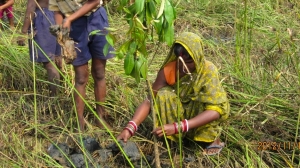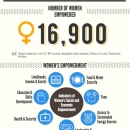Mother Nurture
The age old connection between women and the environment, and the way forward
Location: Bangkok, Thailand. 8th Mar 2016
On the occasion of International Women’s Day, IUCN Asia would like to celebrate women’s significant contributions to environmental protection, and use the opportunity to highlight the work that needs to be done in order to achieve gender equality and ensure women’s rights in society.
In South and Southeast Asia, women make up around 47% of the fisheries workforce. They also make up 43% of the agricultural workforce in developing countries and account for around 66% of the world’s subsistence livestock keepers. Gender-specific duties in remote communities are typical - childrearing, household duties, cooking, and cleaning are traditional roles of women and girls.
Despite the fact that women in Asia play a critical role in the conservation, management and use of biodiversity, their contribution is often overlooked and undervalued. Overall, women’s knowledge and experiences are not reflected in the development of environmental policy and governance.
“Women have strong potential as agents of change and their leadership is critical when discussing environmental conservation policies and practices. Yet women face conditions that limit their full participation,” explains Aban Marker Kabraji, Regional Director, IUCN Asia.
Working women's empowerment into conservation initiatives
The theme for this year’s International Women’s Day, “Planet 50-50 by 2030: Step it up for Gender Equality”, is well-aligned with IUCN’s gender policy which calls for the promotion of equity and equality as a crucial factor for environmental sustainability and an integral part of all conservation efforts.
Through its work with Members, Commissions and partners, IUCN follows a proactive approach to ensure that the interests of both women and men are explored and integrated during the formulation and implementation of its projects.
IUCN’s coastal resilience initiative Mangroves for the Future (MFF), for example, established gender as a cross-cutting and strategic consideration in its programme. More than half of the 155 projects implemented by MFF from 2010 to 2014 responded to gender needs and interests of local coastal communities. And more than 80% of these gender-responsive projects resulted in a visible increase in women’s income, including providing education and skills development to women and their families.
“With increasing capacity for monitoring gender impacts and women’s empowerment, MFF projects are increasingly able to demonstrate their responsiveness to context-specific gender needs and interests, and to make contributions towards closing the gender gap by improving women’s access to and control over resources,” says Maeve Nightingale, gender focal point for MFF and IUCN Asia.
Across Asia, IUCN is investing in a number of projects which will have a transformational and lasting impact on women and families for generations to come.
For example, in Lao PDR the Mekong ARCC project works with local authorities to make natural resources more accessible to women, relieving them of their burden of having to spend significant time in their day collecting drinking water for their families’ drinking, cooking and cleaning needs.
In Bangladesh, as part of a community-based sustainable management project for Tanguar Haor, a unique wetland ecosystem of national importance, women occupy 26% of leadership posts in Village Co-Management Committees - responsible for the co-management of wetlands around their village.
Through an MFF project in Pakistan, 55 local women who previously had no access to income-generating activities were trained in vocational skills, such as home-based baking and embroidery, in support of the development of local livelihood options.
Women and decision making
Moving forward, IUCN is putting a more deliberate focus on integrating consideration of gender into its programme, with gender increasingly being recognised as a critical part of the stakeholder empowerment process.
IUCN plans to work closely with governments in developing and implementing action plans which provide guidance on policy issues and initiatives that need to be taken into consideration when looking at how to address environmental issues in a gender-sensitive manner.
IUCN is currently working with the Japan Biodiversity Fund, and the Secretariat for the Convention on Biological Diversity (SCBD) to build the capacity of developing countries to integrate gender considerations into their biodiversity policy, planning and programming. The collaboration is exploring options to work with two pilot countries in Asia – Sri Lanka and Lao PDR, to support the integration of gender into their National Biodiversity Strategies and Action Plans (NBSAPs).
In addition, it is expected that more and more gender responsive MFF projects will emerge as the gender integration process becomes more familiar and common practice, and gender indicators are mainstreamed into the project’s Monitoring, Learning and Evaluation framework.
A lot still needs to be done. Recognising that women can play en even greater role in helping to build a more sustainable future, IUCN will continue working with its partners to ensure that women’s voices are heard and their unique understanding of natural resource management is taken into consideration when designing and implementing projects.

